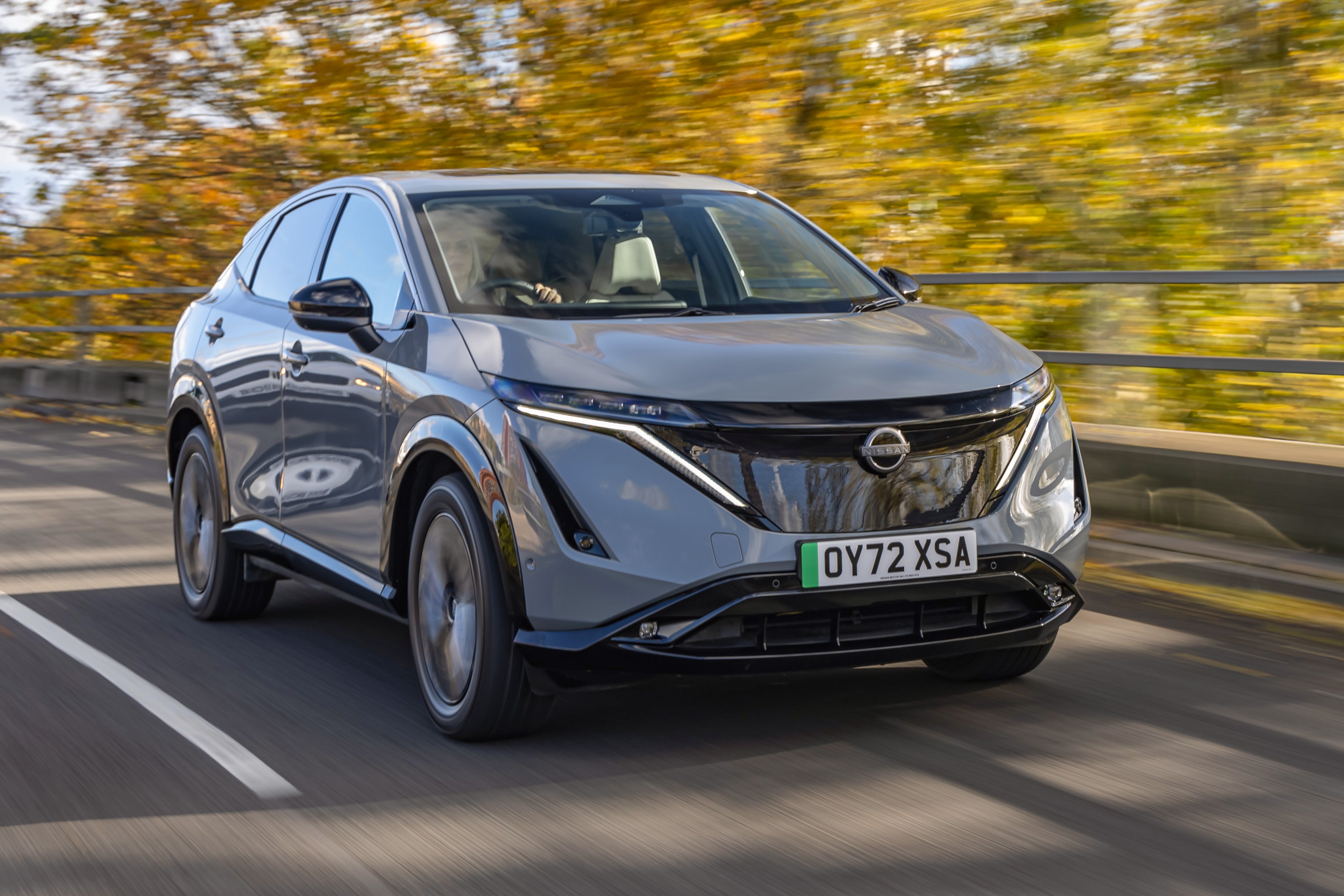Nissan Ariya Review 2025: Price, specs & boot space
Written by Lawrence Allan
Quick overview
Pros
- Distinctive design
- High quality, spacious and well-equipped cabin
- Good all-round driving experience
Cons
- Rivals can be charged more quickly
- Haptic controls are an acquired taste
- Boot space isn't much to write home about
Verdict: Is the Nissan Ariya a good car?
"The Nissan Ariya is a late arrival from a brand that helped kickstart the EV revolution. As an electric SUV, it has plenty of rivals, then, but by taking its time Nissan has made the Ariya competitive and moved the game on a long way from the Leaf. As this Nissan Ariya review shows, it's a strong all-rounder, but some key alternatives beat it in some areas."
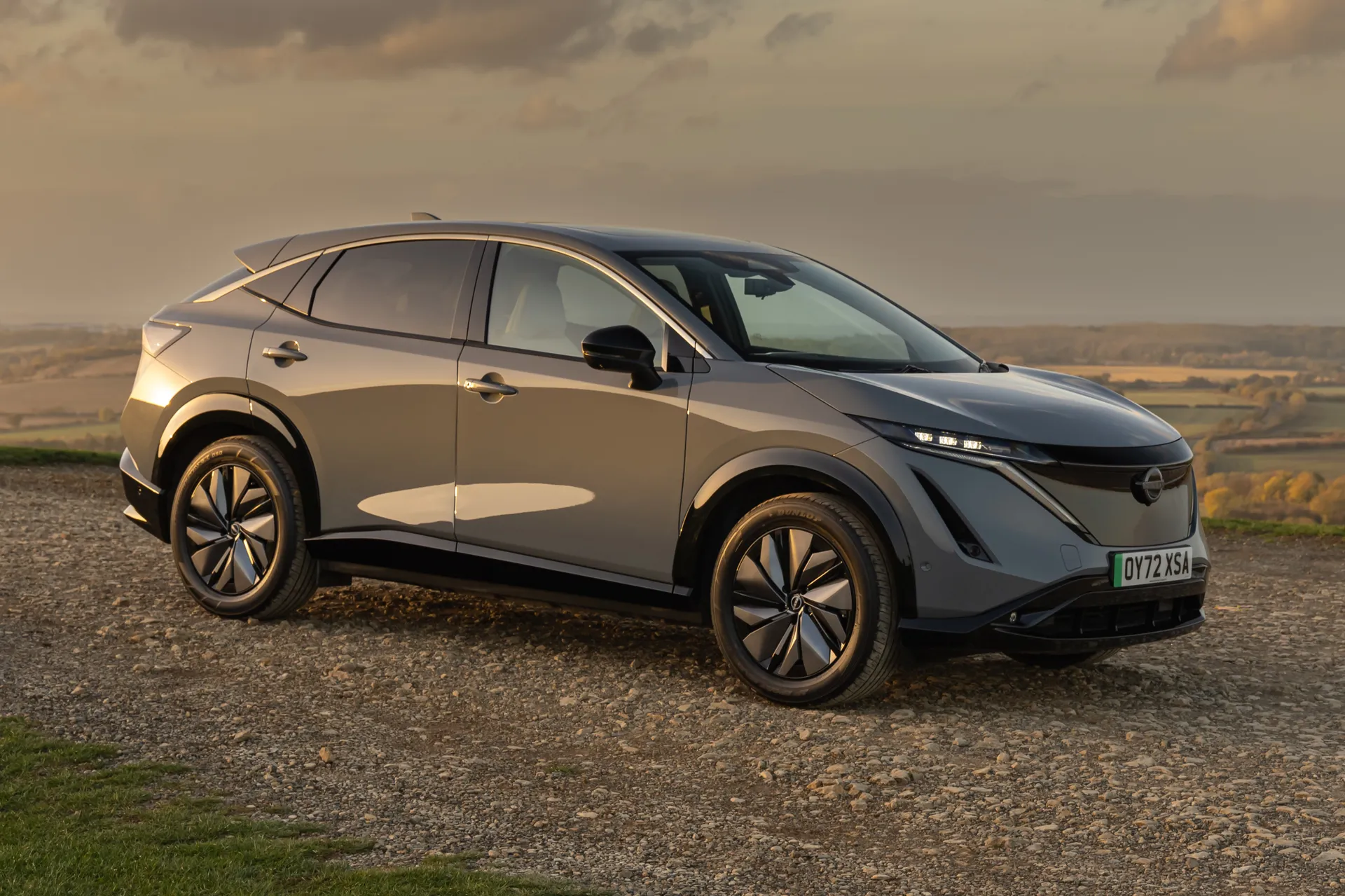
Nissan is very proud of its electric-car heritage, and rightly so. The original Leaf will go down in history as one of the key pioneers of the mainstream EV market, being the first widely available and affordable mass-market electric model from an established brand.
That was over a decade ago, however, and the electric car market has matured very quickly. The current, second-generation Leaf is still popular but not nearly as desirable to buyers as the growing amount of glitzier, fresher alternatives from other brands (Tesla, for one). It's also not an SUV, and that's very much where the money is nowadays: the Qashqai has Nissan's best-seller for years. Enter the Nissan Ariya.
The Ariya is a family-sized electric SUV that's priced from around £40,000, which means it has a huge amount of competition. Our favourites in the class include the Skoda Enyaq, the Kia EV6 and the Hyundai Ioniq 5, while there's also the Tesla Model Y, the Volvo XC40 Recharge (later renamed as the EX40) and the Ford Mustang Mach-e, plus a seemingly constant stream of new arrivals.
The Nissan Ariya has to be competitive and desirable, then, and on first impressions it does a pretty good job at the latter. The swoopy, modern design is a world away from the now dated-looking Leaf, with neat details such as the unique lighting signatures front and rear. Our only reservation is that plumping for an Ariya with smaller wheels makes it look a little ungainly in the side profile: quite a few large modern cars suffer from this, though.
But it's the cabin that's a real step forward for Nissan. This is far from just an electric Qashqai, with a noticeable step up in material quality, an attractive design, cool details and advanced technology including a dual-screen infotainment system. It's also spacious, especially for passengers with long legs in the back. However, the boot is a letdown, with key rivals offering a fair bit more space back there.
You can get the Nissan Ariya with two battery sizes and variety of power outputs, including a couple of high-performance 'e-4ORCE' models with dual motors. There's even a sporty Nismo model. You also choose from a handful of trim levels, but whichever version you go for, there's plenty of kit. A range of up to 330 miles on a charge is very competitive, if not class-leading, while some rivals offer faster peak charging speeds, too.
Nevertheless, the Ariya offers a good all-round driving experience. Nissan admits that it's "not trying to build a sports car, but find the sweet spot", and the Ariya manages to offer composed (if unexciting) handling and a comfortable ride.
Overall, while there are faster, quicker-charging and more practical alternatives, the Nissan Ariya is a welcome addition to the class and a sign of Nissan returning to form with electric cars.
Looking for a used car for sale? We've got 100s of Nissan Approved Used Cars for Sale for you to choose from, including a wide range of Nissan Ariya cars for sale.
Is the Nissan Ariya right for you?
The Nissan Ariya is a good buy if you're looking for an electric car that offers desirability, technology and interior space, and don't mind paying a bit more outright to benefit from the running cost savings of an EV.
It's less suitable for those looking to carry very large loads of luggage due to the unremarkable boot space, and those on a budget may be better served by alternatives with more affordable trim levels on offer, such as the Volkswagen ID.4.
What’s the best Nissan Ariya model/engine to choose?
We've only driven the Nissan Ariya so far with the smaller 63kWh battery, which offers an official range of 251 miles. That should be sufficient for most people's needs, as will the pretty generous level of equipment offered in entry-level Engage trim.
The entry-level car's performance should be sufficient for many, too, but keen drivers may want to look at the four-wheel drive models, which offer noticeably faster acceleration on paper.
What other cars are similar to the Nissan Ariya?
The Nissan Ariya's key competitors are the Volkswagen ID.4, Kia EV6 and Hyundai Ioniq 5. Both offer a similar blend of rational and emotional appeal, broadly similar pricing (although the ID.4 is the cheapest of those competitors) and a similar size.
The Kia and Hyundai aren't quite proper SUVs, though, more taller and longer hatchbacks. There's the Skoda Enyaq, which is probably less desirable than the Ariya but more practical. The Ford Mustang Mach-e is a little bit more expensive but offers the added desirability of its Mustang sports car-aping design and badge. The Volvo XC40 Recharge matches the Ariya with a taller, more SUV-like stance, but it doesn't offer the space of the Nissan, and nor does the Mercedes EQA.
There's also the Tesla Model Y, which is much faster and more practical than the Ariya but also considerably more expensive to buy. Further competitors include the Toyota bZ4X, the Renault Megane E-Tech Electric, the Genesis GV60 and the Polestar 3.
Comfort and design: Nissan Ariya interior
"The Ariya's cabin is probably the most impressive thing about it. This is new territory for Nissan: it looks and feels premium, the detailing is lovely, the tech is bang up-to-date and there's plenty of space, although there are some niggles."
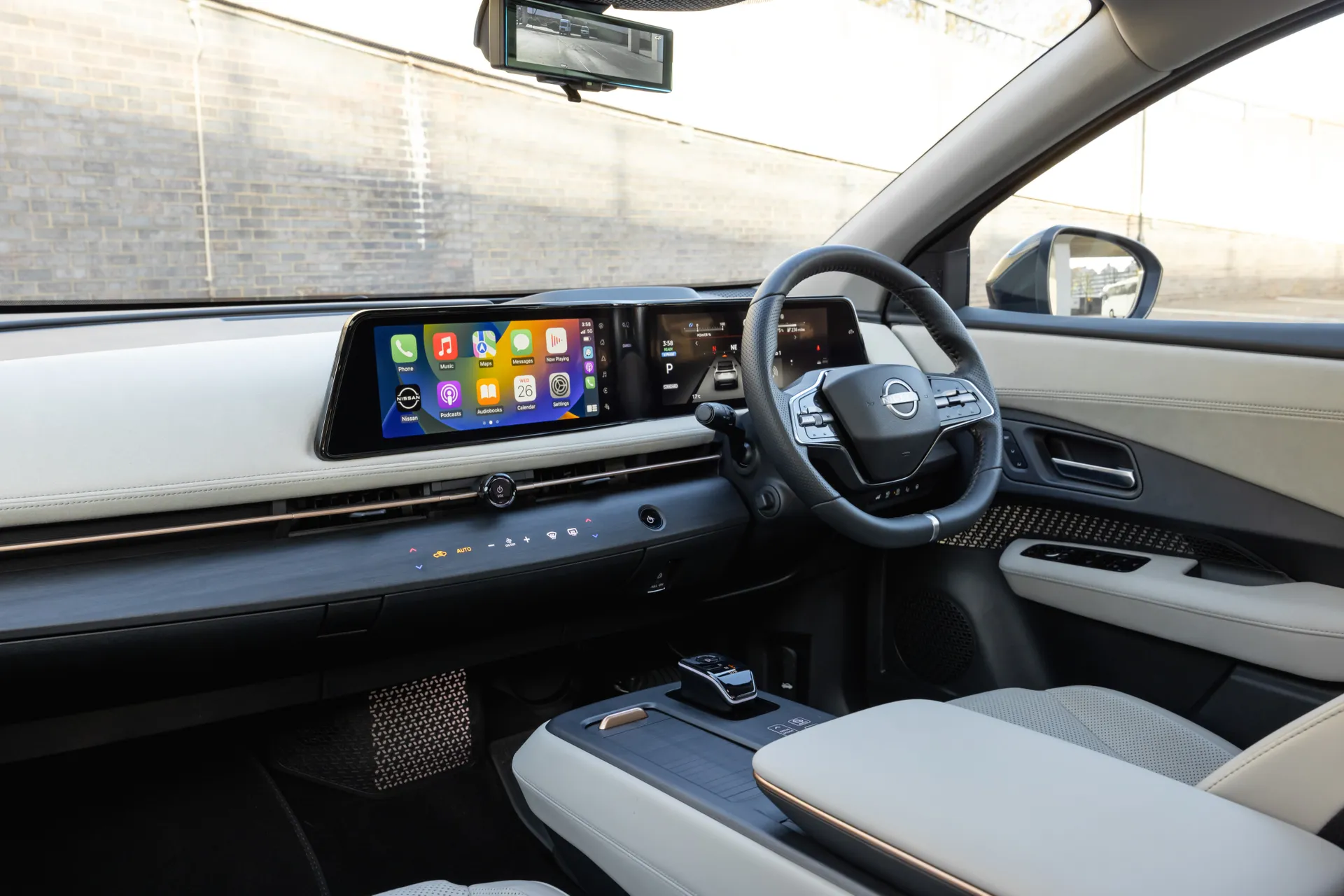
Nissan isn't known for particularly exciting and upmarket cabins, but after years of rather functional designs, recent models such as the latest Qashqai and Juke have really upped the firm's game. The Ariya is easily Nissan's best yet, however, and helps to justify its price.
Step in and the first thing you notice is the sheer quality. Whereas the Nissan Leaf is rather drab and dated inside, the Ariya looks modern and feels pretty plush. There's lashings of suede material on the door cards and on the dashboard, appealing wood finishes on the centre console and a neatly curved dual-screen display panel across the top of the dashboard. In fact, it reminds us of a cut-price BMW iX inside, which is a very good thing.
It certainly looks and feels like more of a premium product inside than efforts from VW and Skoda. There's more surprise and delight when you look closer, too: for example, the climate controls sit flush with the wood trim dash panel and are nicely backlit, with haptic feedback.
Evolve trim gets a motorised centre console that moves back and forth 15 degrees, and even an electrically opening and closing central cubby in the dash centre. All models get neat backlit dotted panels on the doors and in the footwell, too. None of that is strictly necessary but it helps give the Ariya a more special feel than many of its rivals.
You also get a very comfortable driving position, with a nice balance between sitting up high to give a commanding view out, but not feeling too perched up. Forward visibility is good, too, but the narrow rear window combined with the chunky rear spoiler means the view out of the back could be better. At least even base models get a 360-degree around-view camera system to help matters.
Quality and finish
The Ariya has easily the most high-quality cabin of any Nissan we've tried to date. We really like the wood trim strip across the dashboard and centre console, plus the suede touchpoints on the doors and dash. Unfortunately the latter is only standard on higher-spec Evolve trim, and we've yet to sample an lower-spec model without it to give you an idea of what that's like.
General fit and finish seems good, too, with no rattles or wobbly bits of trim. The glovebox lid and lower areas of the dash are made of harder, scratchier plastic, but the same is true of pretty much every rival. Options include Blue Nappa leather upholstery for the seats, part of which is synthetic for a more eco-friendly approach.
If we were being really picky, the switches between the central volume knob for skipping songs and the hazard warning lights - which are meant to be neatly integrated into the air vent trim - didn't quite line up straight on our car. But that's all we can really complain about.
Infotainment: Touchscreen, USB, nav and stereo in the Nissan Ariya
Every Nissan Ariya comes fitted with a pair of 12.3-inch displays combined into one smart-looking display panel. You get standard navigation, over-the-air updates, remote and connected services and a 'Virtual Personal Assistant'.
The sat-nav has intelligent route planning, using real-time information not just on the traffic level but also the status of charging points along your routes. You also get Amazon Alexa integration.
The infotainment screen is decent enough, with plenty of features and reasonably good touch response. The graphics aren't as premium as the rest of the interior, though, and the same applies to the instrument display which, while clear and multi-functional, isn't the best in the business.
Still, at least you get wireless Apple CarPlay and (sadly wired) Android Auto so you can bypass Nissan's software and run your own smartphone apps. There's a wireless charging pad below the centre armrest on every model except the entry-level Engage, too, plus a few USB sockets and a 12V socket.
We have some reservations about the Ariya's use of haptic touch-sensitive controls throughout the cabin. While they look great and make the car feel futuristic, and they do give you physical feedback to confirm that your selection has been registered, the ones on the centre console require a committed stab to work and the steering wheel buttons are a little fiddly and confusing. Normal buttons for essential features would be easier to use on the move.
You also get a 10-speaker Bose sound system as standard on Evolve trim, while this is optional on lower grades. Evolve trim also features a head-up display, too, plus an intelligent rear-view mirror that can become a camera display of the rear view at the flick of a switch: perfect if you have a loaded-up boot blocking the rear screen.
Space and practicality: Nissan Ariya boot space
In terms of exterior dimensions, the Nissan Ariya is 4,595mm long, 1,850mm wide and 1,660mm tall. That makes it roughly the same size as a Volkswagen ID.4, but shorter and taller than a Kia EV6 and Skoda Enyaq.
It's not as large an SUV as you might think on the outside, then, but there's still a very good amount of cabin space. Up front, the lack of a central transmission tunnel (like you often get on a petrol or diesel car) gives loads of leg space and a central area you could store a rucksack in, although because there's no divider, there's a risk it could slide under the pedals. Generous headroom and cabin width up front means that drivers of all shapes and sizes can get comfortable, too.
You get electrically adjustable front seats on Advance trim and upwards, so all but the entry-level Engage trim, while Evolve trim brings memory adjustment for the seats, mirrors and the (now electrically adjustable) steering wheel. There's loads of adjustment, while being able to electrically slide the centre console back and forth adds to the flexibility.
Rear legroom is very generous, up there with the Skoda Enyaq and even more than in the Kia EV6 and Hyundai Ioniq 5, while a flat floor and wide cabin means three in the back isn't too much of a squeeze. The floor isn't too high like in some EVs, either, although you still can't fully slide your feet under the front seats.
Headroom in the back is significantly less generous than the legroom (more like the Kia in this respect) due to the sloping roofline, and the panoramic sunroof of the Evolve grade hampers this further. Even with it fitted, though, six footers can just about get comfortable without feeling hemmed in.
The boot is the biggest disappointment when it comes to practicality, simply because its outright capacity is less than in many rivals. At 466 litres for the two-wheel-drive model, it's already behind rivals from VW, Skoda, Kia and Hyundai, although it is at least bigger than in the Mustang Mach-e. Even worse is that the four-wheel-drive model takes that capacity down to 408 litres by removing the underfloor storage. There's no front boot area, either.
And that's a pity, because the boot itself is a decent shape, plus front-wheel-drive variants get an underfloor storage area that's plenty big enough for the charging cables. You also get an electric tailgate on every variant except the entry-level Engage, and the opening itself is large, although because the Ariya is higher off the ground than some rivals, you need to lift items up a bit more to load them. The seats fold in a 60/40 split, with a central ski hatch, but there are no levers in the boot to fold the seats.
Handling and ride quality: What is the Nissan Ariya like to drive?
"The Nissan Ariya strikes a nice balance between comfort and refinement and composed handling, although it's not exactly exciting."
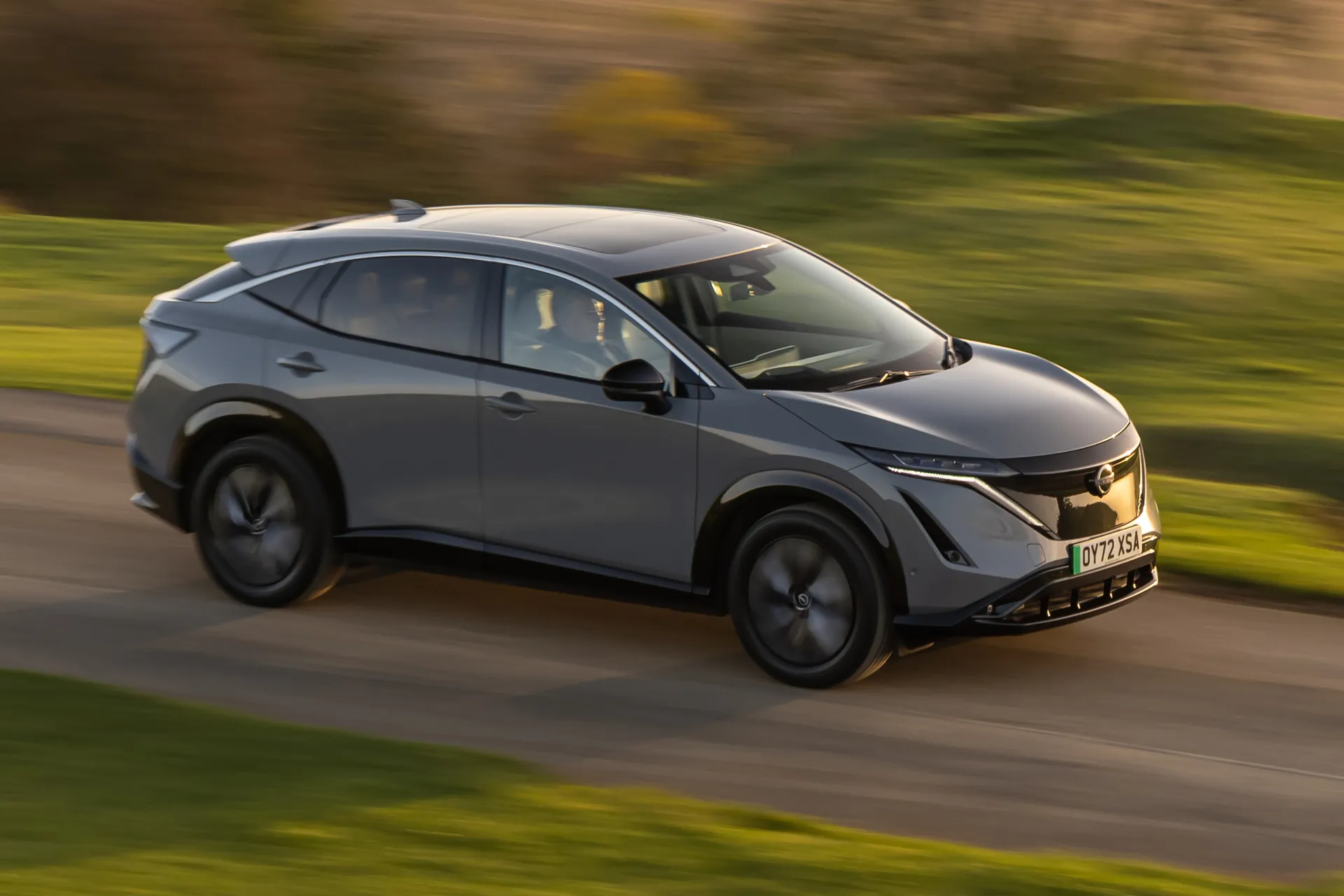
Nissan has focused on making the Ariya's driving experience work for the majority of buyers, balancing the need for handling that isn't too soft and wallowy with the ability to smooth over the worst bumps our roads can throw at it. And on initial impressions it's done a good job.
The Ariya's steering is nicely weighted - not too light and not too heavy - with a keen directness helping boost the feeling of agility. There's not too much body lean, either, although the two-wheel-drive model we drove weighs under two tonnes, whereas heavier versions are nearly 2.3 tonnes, and that could affect how keen it feels to change direction. At least you get 50:50 weight distribution for balance.
Two-wheel-drive models have plenty of grip most of the time, but as they are front-wheel drive and many rivals are rear-wheel drive, the Ariya can struggle to get all of the instant torque down if you floor it, triggering the traction control.
The best thing about the way the Ariya drives is its ride quality. Often electric cars can struggle to be truly smooth because the heavy batteries result in the suspension being stiffened up to cope. It feels pliant and well-damped over bumps, no doubt helped by the smaller 19-inch wheels on our test car.
The Ariya's ground clearance of 185mm is more than key rivals, which may be a benefit for some who have rutted tracks instead of a driveway. We don't expect it to rival the best 4x4s off-road, but it should get further than many electric SUVs as a result.
The Nissan Ariya's brakes are worth talking about, too. Some EVs and hybrid cars have odd brake feel because they are combining normal friction brakes with regenerative braking, making it really hard to smoothly come to a stop. The Ariya's are excellent, with a natural feeling pedal making it a doddle to slow down without being jerky.
What motors and batteries are available in the Nissan Ariya?
The Ariya can be had with two battery sizes and a variety of power outputs. The entry-level version with a 63kWh battery puts out 217PS and 300Nm, which is enough for a perky but not rapid 0-62mph time of 7.5 seconds.
The bigger 87kWh battery comes as standard with 242PS and the same 300Nm of torque. Despite the extra power it's actually a tiny bit slower due to the heavier battery pack, managing 0-62mph in 7.6 seconds. It's worth noting that both of these variants top out at 100mph, although that only really matters if you're on a German Autobahn.
Then there are the all-wheel drive e-4ORCE models. The first of them puts out a decent 306PS but a whopping 600Nm (double the torque of the standard car). It's much faster, then, with a 0-62mph time of 5.7 seconds and a top speed of 124mph. That's still some way off a dual-motor Volvo EX40 and even an entry-level Tesla Model Y, but it'll be more than enough in a family SUV. You then have another option with 394PS and the same 600Nm of torque, and this trims the 0-62mph sprint down to 5.1 seconds. Then there's the more-recently-added Nismo version, which produces 435PS for a 0-62mph time of 5.0 seconds.
So far we've only driven the entry-level model and even that is plenty potent enough for this type of car, particularly for zipping around town and up to speed on the motorway. Unless you're regularly engaging in the traffic light grand prix, it'll be fine, and it feels quicker than petrol or diesel family SUVs because you get instant throttle response and power.
Nissan Ariya range: How far can you travel on a charge?
The Ariya manages a WLTP-certified range of 251 miles in 63kWh form, which rises to 330 miles with the 87kWh battery. Opting for the dual-motor e-4ORCE model drops the latter down to 314 miles on the lower powered model, and 310 miles for the more potent one. Range on the Nismo falls further to 261 miles. Expect all of those figures to be a little optimistic in real-world use.
Those figures are very competitive, but not quite the best in this class, with the bigger battery broadly matching the Kia EV6 in front-wheel drive form and beating it in all-wheel drive form. It's similar to the Skoda Enyaq's range, too, for both versions, and even gets close to the Tesla Model Y.
If you want more range than this you'll need the Ford Mustang Mach-E Extended Range, which officially manages up to 379 miles on a single charge.
Refinement and noise levels
The Ariya is super-quiet and smooth around town, with no motor whine to speak of and very little tyre noise. Wind noise is a little more noticeable than in some lower-down, more streamlined alternatives, but it's far from intrusive and is noticed more simply because of the lack of engine noise.
Safety equipment: How safe is the Nissan Ariya?
The Nissan Ariya comes with plenty of safety kit as standard, including intelligent lane keep assist, blind spot intervention, rear cross-traffic alert, front- and rear automatic emergency braking with pedestrian and cyclist detection and predictive forward collision warning.
You also get Nissan's 'ProPILOT with Navi Link' as standard from Advance grade upwards, which is basically advanced adaptive cruise control with steering assistance to keep you in your lane. Automatic parking comes as standard here, too, while Evolve grade gets 'ProPilot Park', which is even cleverer.
Euro NCAP awarded the Nissan Ariya a full five stars for safety following its stringent crash tests in 2022.
Nissan Ariya charging times: how much does it cost to charge?
"The Nissan Ariya isn't the fastest-charging electric car out there, but it should pull a consistent speed from a rapid public charger."
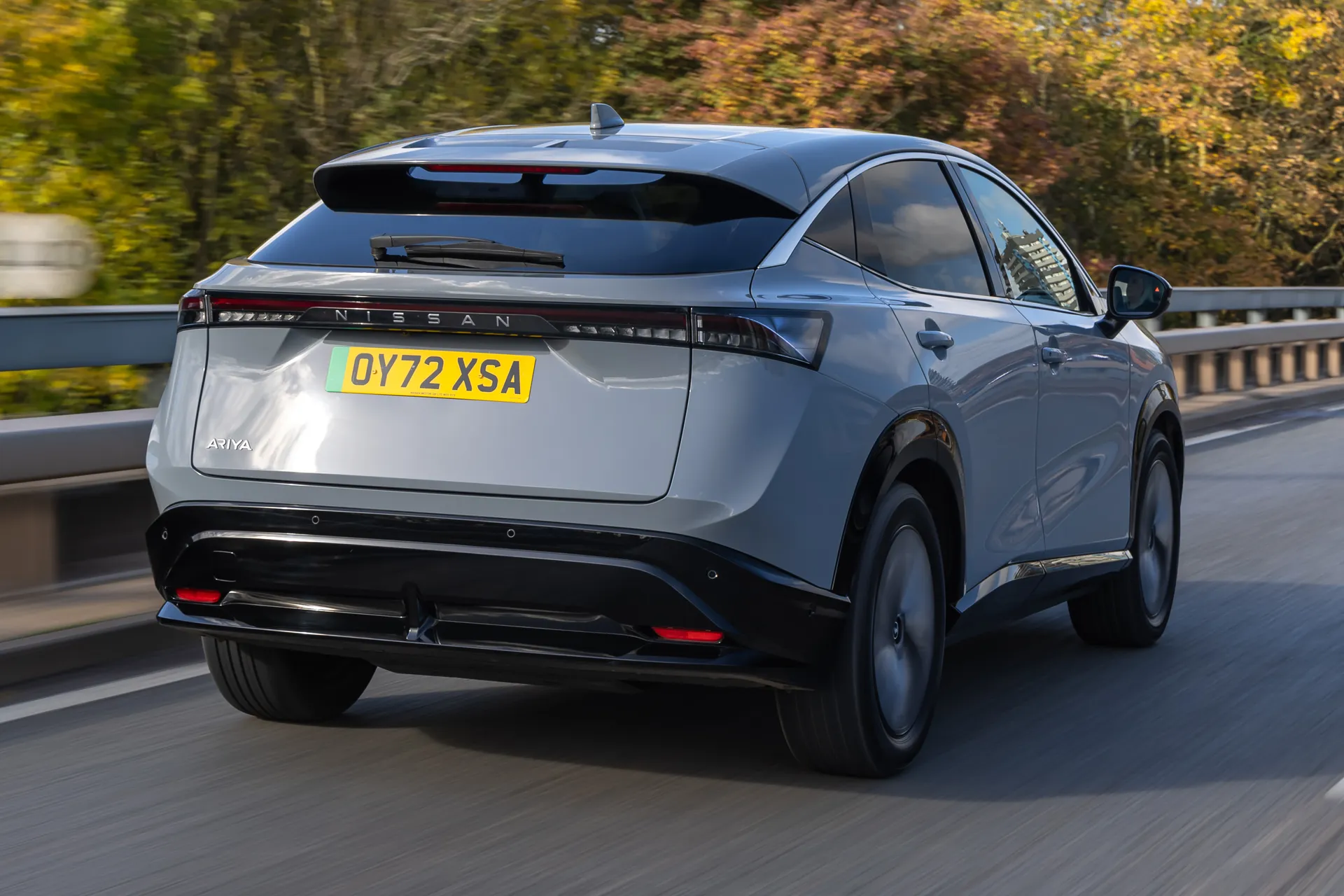
The Nissan Ariya will accept charge at a maximum charging speed of 130kW. That's not awful, but it's certainly not the fastest out there: rivals from Kia and Hyundai, along with Tesla, will peak at over 200kW.
However, Nissan claims that where rivals claim better peak speeds and drop off quite quickly, the Ariya is more consistently able to reach and maintain speeds while plugged into a suitable rapid charger. The 63kWh model can go from 20-80% charge in as little as 28 minutes, with the 87kWh model taking 30 minutes.
On a standard 7kW home charger, you'll need up to 10hrs for the smaller battery and 14hrs on the bigger battery for a full charge. But Ariyas with the bigger 87kWh battery come as standard with a 22kW on-board charger, which with a suitable three-phase home wallbox (which are admittedly rare) will speed that up a fair bit.
In terms of the cost? The bigger battery model will cost around £7 with the cheapest home electricity tariff, but i'll be more like £35-40 on the fastest rapid chargers depending on supplier.
Nissan Ariya reliability and warranty
Nissan has a fair reputation for reliability as a brand, finishing in the middle of the table in most editions of the HonestJohn.co.uk Satisfaction Index. In the latest 2025 edition, meanwhile, it came 23rd out of 33 carmakers in the reliability standings.
We've not heard any horror stories about the Ariya's reliability, but its warranty cover is fairly ordinary. Most of the car is covered by a bog-standard three-year, 60,000-mile arrangement, while EV-specific parts are covered for five years or 60,000 miles, while the battery is covered for eight year or 100,000 miles.
Nissan Ariya insurance groups and costs
The Nissan Ariya starts in insurance group 31, rising to group 35 for the bigger battery model and group 41 for the dual-motor variant. The highest grouping is for the 394PS variant, which sits in group 44: strangely, the more powerful 435PS Nismo sits lower in group 41. That certainly won't make the Ariya cheap to insure, but it's about par for the course for EVs at this size, performance and price point.
VED car tax: What is the annual road tax on a Nissan Ariya?
When the Nissan Ariya was first released, you didn't pay a dime in VED (road tax) on it due to the fact that it's electric. This exemption has now been lifted by the government, though, so you now face the same flat rate as buyers of petrol and diesel cars, a flat rate that currently stands at £195 per year.
That's not all, however. At the same time that the government withdrew VED exemption for EVs, it also withdrew their exemption from paying the hefty luxury car surcharge. This surcharge applies to cars that cost £40,000 or more when brand new (including any optional extras fitted), and on top of the flat rate, owners need to pay another £425 between years two and six of the car's life. That amounts to quite a chunk.
Currently, only one version of the Ariya costs less than the threshold, and only marginally: adding any single one of the optional extras available - metallic paint, for example - is enough to take it over the threshold. As a result, almost all Ariyas will be liable for this extra cost.
Nissan Ariya price
"The Nissan Ariya is on a par with mainstream electric car rivals in terms of pricing, and is expected to hold its value well."
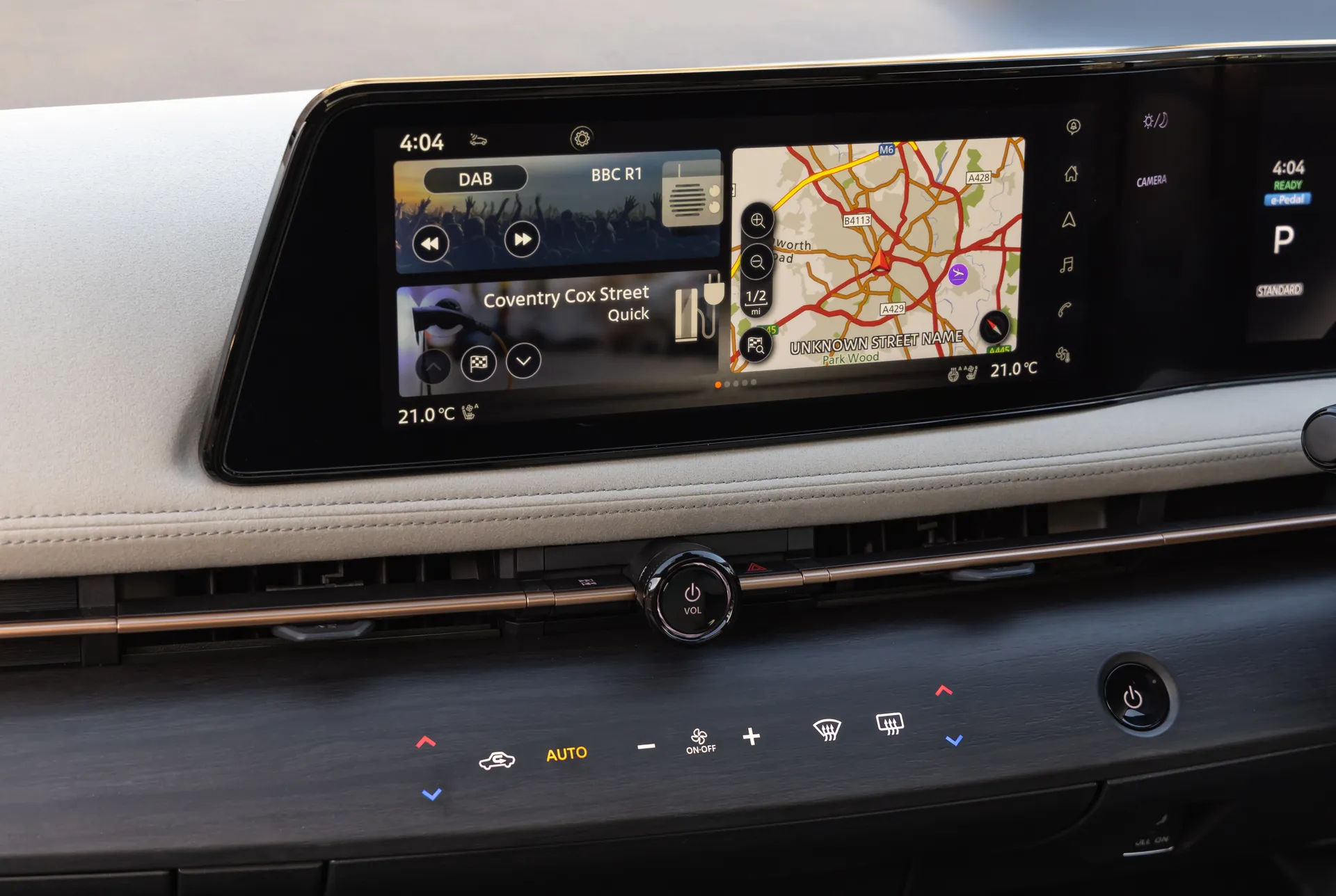
The Nissan Ariya range starts at around £40,000 for the lowest-spec 63kWh car, and rises to around £60,000 for the priciest version. Look to the used car market, though, and you can trim quite a slice off that. The cheapest examples in our listings can be had for less than £25,000, a very useful saving.
Most of these are early Advance cars (these were the entry-level model at launch before the Engage trim was introduced later), and all should have less than 10,000 miles on the clock. Those after the larger battery car will be looking more in the region of £30,000 or thereabouts.
Trim levels and standard equipment
The Nissan Ariya offers a very impressive level of standard equipment for an electric car of this price point. Take a deep breath before reading these...
The entry-level Nissan Ariya Engage comes with full LED lighting, 19-inch alloys, dual-zone climate control, a heat pump, ambient lighting, electric windows, rain-sensing wipers, a suite of driver assist tech including blind spot intervention and rear cross traffic alert, dual 12.3-inch displays, sat-nav, a reversing camera system and wireless Apple CarPlay.
Second-rung Advance trim adds electric and heated front seats, a heated front windscreen, a powered tailgate, synthetic leather upholstery, a 360-degree camera system and adaptive cruise control.
Stepping up to the Nissan Ariya Evolve brings 20-inch alloys, a panoramic sunroof, adaptive beam headlights, the motorised centre console and electrically opening dash cubby, the intelligent rear-view mirror, ventilated front seats and heated rear seats, electric memory steering wheel adjustment, suede dash trim, a head-up display, an Advanced Intelligent Key, a Bose sound system and ProPILOT self-parking. Evolve+ trim is only available with the 394PS powertrain, and as well as the extra pace, gets blue Nappa leather upholstery. The Nismo, meanwhile, gets sportier styling and a reworked suspension.
Ask the heycar experts: common questions
Is the Nissan Ariya a good car?
How fast is the Nissan Ariya?
How much is the Nissan Ariya in the UK?
Get our latest advice, news and offers
Keep me updated by email with the latest advice, news and offers from heycar.
By submitting you agree to our privacy policy
